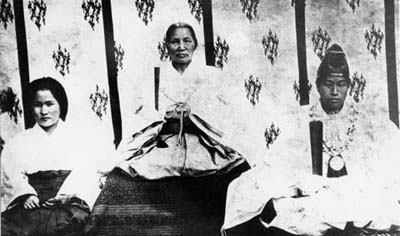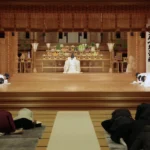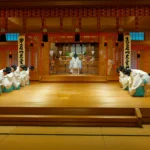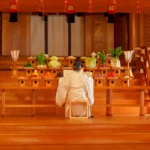By Ruth Reiner
Hi there! A bit about Nao today. ‘Cause that’s where we left off last time:
Nao (later to be known as Nao Deguchi), was born in 1837 in Tamba Province, to a family at the bottom. of the social ladder. Her Father was a carpenter called Gorosaburo Kirimura. At the age of nine when Nao’s father passed away, Nao had to go to work. In the day time she worked as a servant, and at night she worked spinning yarn. And so, Nao could not receive any formal education and could neither read nor write.
“Nao’s mother Soyo was born into the family of a man called Deguchi, and Soyo’s younger sister Yuriko was supposed to continue the line of another branch of the Deguchi family in Ayabe. However, Yuriko’s husband died without leaving any children, and so in 1853 Yuriko adopted Nao to carry on the family line. In 1855, at the age of eighteen, Nao married an adopted son, who became the heir of the Deguchi family.” (chapter 5, ”The Great Onisaburo Deguchi”)
Between the ages of nineteen and forty six, Nao gave birth to eleven children (three died in infancy). Her husband was an unsuccessful carpenter with a drinking habit, that led the family into great poverty. Finally, they had to sell their house, and sent the children out to work as servants. Later, Nao’s husband injured himself and became handicapped. One son tried to commit suicide, a daughter took off with a gambler, another son was adopted into the family of a gambler, another daughter ran off to Kyoto, and another son eventually joined the Imperial Guard and was reported missing in action during the Sino-Japanese War.
In order for Nao and the remains of her family to stay alive, Nao became a rag collector, her husband Only on his death bed did finally express his respect for her in tears. When he died Nao was fifty years old. The year was 1887.
“Nao, wanting to give her dying husband a last cup of Sake, took their only remaining asset, the scales on which she weighed her rags and waste paper, to the pawnshop to try to get some money for the sake.” (ch. 5)
In 1892, Nao’s life started taking quite a turn, as she started going through some mysterious experiences. She began feeling some great power in her which started in her stomach and arose, manifesting itself as a voice, introducing itself as the God Ushitora no Konjin.
At first Nao with all her misfortunes in life could hardly understand why she would be picked for such a mission of being the medium for Ushitaro no Konjin, and was even worried that some low spirit was trying to lead the world astray. She tried to fight this possession, by fasting and not sleeping, but the spirit was still there. Finally she could understand that this might just have been the purpose of her life. In the beginning, Nao got into trouble several times, when this voice would speak out loud and lead to misunderstandings. The first time, she was put in jail. The second time, she was forcibly confined in a small room for forty days.
Wile in detention in this room Nao asked the spirit to avoid using this loud voice. And so, the spirit led her to pick up a nail “and strangely enough, her hand moved of its own accord and scratched some characters on a pillar. “ (ch. 5)
This was the beginning of Nao’s automatic writing (Ofudesaki), which was later to continue on proper paper. By the time of Nao’s death in 1918, there were some one hundred thousand sheets.
After Nao was released from detention she started preaching. She also had power to heal the sick. Prophesies she made came true, and so, she was approached by one of the religions of that time to help spread there doctrine. But as some complications arose, Nao left and started a center for the worship of Ushitora no Konjin alone. She was then sixty years old.
One day, sitting in a storehouse her followers had arranged for her, writing her automatic writings, she came across the message that: “A person that will be able to understand these things will appear from the east…” (ch. 6)
And so, as I told you in last week’s item, when Kisaburo first arrived with his comical appearance, Nao found it quite hard to believe that he was the man she was waiting for. Eventually, though, it became obvious to her that he was the one, and so, he joined Oomoto. In Oomoto he became a central figure at the age of twenty-seven. It is said that they were a very good match, as foundress and co-founder, complimentary “yin” and “yang”.

In 1900 Kisaburo married Nao’s youngest daughter Sumiko, and as a result of being adopted into the Deguchi family changed his name to Onisaburo Deguchi. His first name changed since it kept on arising in the Ofudesaki. But before it appeared in Nao’s writings, Kisaburo actually, one day while signing, made a “mistake”, and used the wrong character in the beginning of his name, a character that can be pronounced both as ki and as oni. And so having the name “Onisaburo” appear also in Nao’s writings, seemed more than just a coincidence.
But Oomoto had not yet received governmental recognition, so the police and officials would endlessly come and try to threaten Onisaburo and Nao. Nao was not intimidated by these threats, but Onisaburo and Sumiko, his wife, took them seriously. At that time there were some determined Oomoto followers that provoked the authorities to some more severe threats. Onisaburo understood that things can not continue to go on like this, so he decided to leave Ayabe to find some answers, some new tactics…
I’d love to tell you more today, but I’ve got to go!



